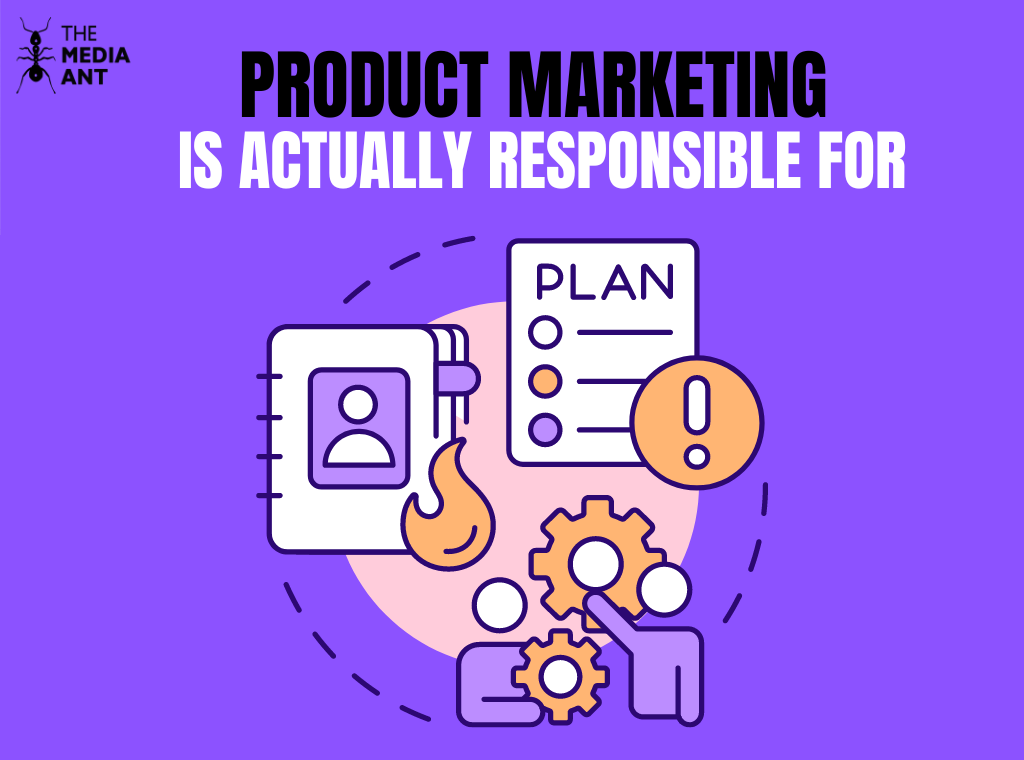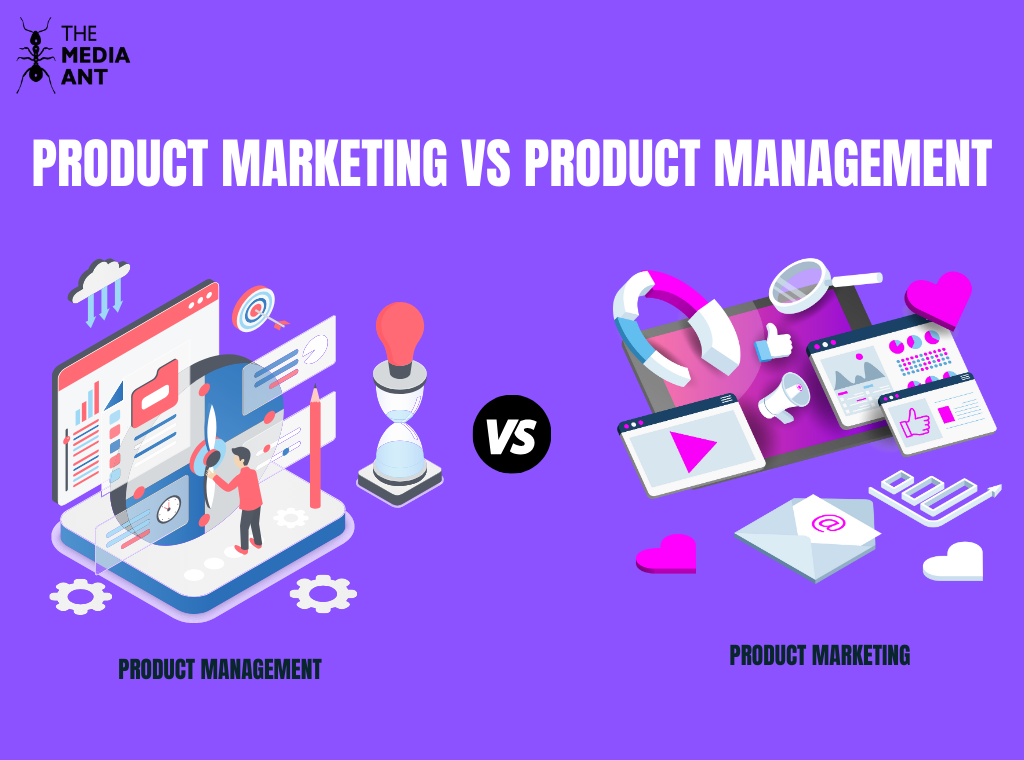To make the world see your great product, you will need to do more than merely launch it. You must have a plan that will help your product get to the right people and satisfy their needs. Product marketing is what happens behind the scenes in order to move a product from an idea stage to being adopted by customers. This blog post will explore some aspects of product marketing like its strategy, responsibilities, why product marketing is important, and real-life examples that will help you understand product marketing in a better way, so grab your favorite beverage and get ready to know the integrities of product marketing.
What is Product Marketing?

Product marketing focuses on the promotion and selling of a product or service. It includes understanding the target audience meeting their needs and creating strategies to effectively convey the product’s value to customers.
Within product marketing various tasks are undertaken, including market research, analyzing competitors, setting prices, determining positioning, crafting messages, creating packaging, selecting distribution channels, and implementing plans. The primary objective is to create interest in the product, boost sales, and enhance profitability.
Product marketers collaborate closely with departments in a company like product development sales teams and marketing communications to ensure consistency in messaging and execution. Their key responsibility is to translate a product’s features and advantages into value propositions that connect with customers and set it apart from offerings in the market.
What is a Product Marketing Strategy?
A product marketing strategy is a guide on how to get your newly launched product into the market and be successful in the long run. It shows how you will position, price, and promote your product so that it may reach your target audience and generate sales. A good strategy considers all stages of a product’s life starting from pre-launch through during launch till the post-launch, now let’s discuss in detail what are the pre, during, and post-launch responsibilities of a product marketer.
Pre Launch Responsibilities
Before you even start building your product, it requires you to do a bit of homework which includes a lot of research and a roadmap on how to market your product.
1. Research
Start by examining your target market. Create a buyer persona and note their pain points. Link each pain point to solutions that your product offers. Moreover, also consider what makes you stand out from other competitors.
Then, delve into the actual product. Though marketers may not necessarily know every single detail about how a product was manufactured, they should learn everything possible- from how its features operate to its measurements.
Lastly, perform a competitor analysis. Look at how well (and not so well) they execute certain aspects of marketing their products as well as their pricing strategy. A SWOT analysis is a perfect tool to help with this.
2. RoadMapping
After completing research, it’s time to build your marketing big picture. This is when you will choose which marketing channels to use. Reflect on how you will use your website along with what paid media options you have and what social media platforms are most valuable for your customers.
Don’t forget to include organic as well as paid advertising, marketing, and PR opportunities. You could make a mind map full of ideas and then narrow down the best channels for this specific product. Maybe you want traditional TV adverts for an old-school brand? Or perhaps trying Instagram for your Gen Z audience.
3. Launch
Now is the time for this to happen. Bringing your product to market is a daunting yet exciting part of any product launch.
4. Rollout
If you have conducted comprehensive research and developed a detailed roadmap, then rollout should be the simplest stage! It is every piece of content that you have created for this launch irrespective of channel. Some pre-launch content may already be up on the site encouraging subscribers to join an exclusive mailing list or notifying them about the upcoming release.
It’s not just about posting content before your pre-launch, it’s also throughout your launch.
5. Reporting
Identify any KPIs you want to track such as social media engagement or click-throughs to your website for pre-ordering or purchasing. This data should be done daily throughout a launch so that as you go along you can adjust accordingly. You may find that some marketing channels have higher conversion rates than others. That means it could be worth scaling back on other mediums and focusing your efforts on more profitable channels.
Post-launch phases
Once you’ve launched your product, you can’t leave it there and move on to the next launch. It’s essential to review what went well, respond to feedback, and retain customers gained from this launch.
1. Response
Collate feedback and reports to determine what you can do better next time. Respond promptly to any issues customers have had and compile information packs for your customer service team. Be upfront with customers about any problems and solve them.
2. Retention
Gaining new customers is great, but you need to keep working to retain them. You could offer them incentives, discounts, or set up a referral scheme for loyalty. Never underestimate the need for great customer service as a retention tool either. Word of mouth is still a powerful form of marketing!
What is Product Marketing Actually Responsible For?

Imagine you created a fantastic fitness tracker, but how do people find out about it? Product marketing is your secret weapon. Product marketing acts as a bridge between a product and the market it serves. From understanding customer needs to creating compelling messages to ensuring stocks, many hats are worn. Here is a breakdown of their key responsibilities:
1. Messaging and Positioning
Marketers define how the product is perceived in the marketplace. This requires clear and concise messaging that highlights the product’s value proposition and is relevant to the target audience.
2. Product launches
Lead the introduction of new products or innovations, generate excitement and ensure a smooth go-to-market process. This includes launching campaigns, creating media and training materials.
3. Sales Manager
Salespeople equip the sales team with the knowledge and resources needed to successfully sell the product. This includes conducting sales testimonials, presentations, and product training.
4. Market research
Continuous analysis of customer needs, market trends and competitor activity. Provides information on Intel’s valuable product development and marketing strategies.
5. Content Management
Marketers often play a role in educating and providing content to their target audience. This can involve blog posts, case studies, white papers, or social media content.
6. Customer Success
While not the only responsibility, product marketing can help develop customer engagement programs and programs to ensure users get the most out of products.
Overall, product marketing is a multifaceted discipline that plays an important role in a product’s success. They bridge the gap between production, sales and customers, ensuring that the product is well positioned, understood and ultimately accepted by the market
Why is product marketing important?
Product marketing is important because it bridges the gap between a company’s offerings and customer needs. By conducting research and better understanding market dynamics, customer pain points and competitive landscapes, brands can develop strategies that differentiate products, develop compelling content and effectively communicate value propositions to audiences that the target audience thus increasing brand awareness, customer acquisition and revenue. Additionally, product marketing provides ongoing feedback, enabling businesses to continuously improve products based on customer feedback and market trends Finally, product marketing plays a key role in continuing business growth, increasing ROI, and building strong, lasting relationships with customers
Product Marketing Vs Traditional Marketing
Here’s a comparison table between product marketing and traditional marketing:
| Aspect | Product Marketing | Traditional Marketing |
| Purpose | Promote and sell a specific product or service | Build brand awareness and reach a wider audience |
| Focus | Highlight product features, benefits, and solutions | Create a favorable impression of the overall brand |
| Audience Targeting | Specific audience segment interested in the product | Broad audience demographic for brand recognition |
| Messaging Content | Detailed and targeted, emphasizing product valueProduct descriptions, case studies, demos, comparison guides | Broad and general, focusing on brand imageAdvertisements, sponsorships, direct mail campaigns |
| Goals | Drive demand for the product, increase sales | Increase brand recognition, create emotional connections |
| Channels | Digital marketing, content marketing, sales enablement | Television, radio, print ads, billboards |
| Measurement | Sales metrics, conversion rates, customer feedback | Brand awareness surveys, reach and engagement metrics |
This table outlines the key differences between product marketing and traditional marketing in terms of their purpose, focus, audience targeting, messaging, content, goals, channels, and measurement criteria.
Product Marketing vs Product Management

Both product marketing (PMM) and product management (PM) are crucial for a product’s success, but they play distinct roles:
Product Management: The Conductor of the Product Orchestra
Focuses on what: The product itself – its features, functionality, and roadmap.
Responsibilities: Conducting market research, defining product vision and strategy, managing the development process, and ensuring the product meets customer needs.
Metrics: Customer satisfaction, product usage data, time to market.
Product Marketing: The Product’s Cheerleader and Strategist
Focuses on why: Why customers need the product and how it benefits them.
Responsibilities: Crafting compelling messaging, creating launch campaigns, enabling sales teams, and gathering market feedback.
Metrics: Product awareness, sales figures, customer acquisition cost.
Think of it this way:
Product Manager: Designs and builds a fantastic new car.
Product Marketer: Creates a marketing campaign highlighting the car’s features, benefits, and target audience. They handle the launch event, equip salespeople with the knowledge to convince customers, and track how well the car sells.
In short, product management steers the product’s development, while product marketing gets the word out and ensures customer adoption. They work together seamlessly to bring a winning product to market.
Examples of Product marketing strategies
Product marketing focuses on the steps people take to purchase your product, and how you can help people adopt and use that product. Let’s look at a classic example.
1. Apple

Apple is a household name in a highly competitive technology market. To stand out from the crowd, Apple ensures that its products are well designed, easy to use and accessible. Apple’s product marketing strategy focuses primarily on the benefits it can offer users, rather than just listing the features you can get from each product.
On almost every product page and every marketing campaign, Apple’s language focuses on what they can do and what they can do to customers. Apple makes a statement with its marketing materials that help consumers overcome challenges.
2. Tesla

Think Tesla, and what do you see? Sleek electric cars, a focus on clean energy, maybe even solar panels. That’s no coincidence. Tesla built its whole image, from car design to marketing campaigns, around this one big idea: a future powered by clean energy. Their mission statement is pretty clear: make electric cars amazing, ditch fossil fuels, and save the planet!
By staying true to this goal, Tesla has become the king of electric cars. They targeted a specific group – people who care about the environment – and delivered with cars like the super popular Model Y. With over half the electric car market share, it’s safe to say Tesla’s strategy is a winner.
Conclusion
In conclusion, product marketing isn’t just about flashy launches or witty slogans. It’s the bridge between a product and the world, ensuring it solves real problems and resonates with the people who need it most. By understanding customer needs, crafting clear messaging, and fostering a strong product identity, product marketing is the secret sauce that turns great ideas into lasting successes. So next time you see a product that seems to perfectly fit your needs, remember the product marketing team behind the scenes, the storytellers and strategists who bring innovation to life.
FAQs on Product Marketing
What is product marketing?
Product marketing is the process of bringing a product to market and driving its success. It involves understanding customer needs, crafting compelling messaging, launching the product, and ensuring its long-term adoption.
What is the product marketing mix?
There isn’t a universally agreed-upon product marketing mix, but it often refers to the various elements product marketers use to influence the market, such as:
Product: The features and benefits of the product itself.
Price: Setting a competitive and sustainable price point.
Place: The channels where the product will be sold (online store, physical stores, etc.).
Promotion: Marketing activities to generate awareness and interest.
What are the types of marketing?
There are many types of marketing, but some relevant to product marketing include:
Content marketing: Creating informative and engaging content to attract and educate potential customers.
Social media marketing: Utilizing social media platforms to connect with target audiences and promote the product.
Search engine marketing (SEM): Increasing the product’s visibility in search engine results.
Is product marketing a skill?
Absolutely! Product marketing requires a diverse skill set, including market research, communication, storytelling, and analytical thinking.
Is product marketing a sales job?
No, product marketing is distinct from sales. While they collaborate to achieve product success, product marketing focuses on creating demand and product awareness, while sales convert that interest into actual purchases.





